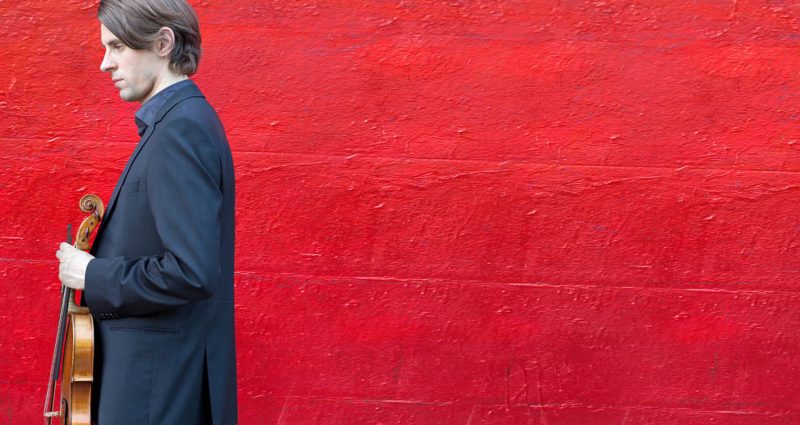- This event has passed.
Beethoven, CHEN, & Coleridge-Taylor
LUDWIG VAN BEETHOVEN (1770-1827)
Piano Trio No. 6 in E-flat Major, Op. 70, No. 2
- Poco sostenuto – Allegro ma non troppo
- Allegretto
- Allegretto ma non troppo
- Finale. Allegro
Mikhail Kopelman, violin • Steven Doane, cello • Julian Martin, piano
CHEN YI (b. 1953)
Xian Shi
Phillip Ying, viola • Luke Rinderknecht, percussion • Pei-Shan Lee, piano
— Intermission —
SAMUEL COLERIDGE-TAYLOR (1875-1912)
Clarinet Quintet in F-sharp Minor, Op. 10
- Allegro energico
- Larghetto affettuoso – Molto espressivo
- Scherzo. Allegro leggiero
- Finale. Allegro agitato
Alan Kay, clarinet • Renée Jolles, Janet Ying, violin • Dimitri Murrath, viola • Jeffrey Zeigler, cello
PROGRAM NOTES
LUDWIG VAN BEETHOVEN
Piano Trio No. 6 in E-flat Major, Op. 70, No. 2 (1808)
Beethoven undertook work on his Op. 70 piano trios during the summer of 1808, on retreat in the Viennese suburban village of Heiligenstadt. He had just completed his Symphony No. 6, the Pastorale, and proposed to send his publisher a bundle of works, including the fifth and sixth symphonies, the Mass in C Major, a cello sonata, and two Piano Trios—since, in Beethoven’s words, “there is a lack of them.” It had been twelve years since Beethoven’s previous trios, the set of three which had been his first published works in 1795.
If the first trio of the set, the famed Ghost trio, exemplifies with its stormy contrasts and quivering slow movement Beethoven’s dramatic style—sharing certain emotive impulses with the Fifth Symphony—the trio on today’s program, with its convivial cheer and the gentle grace of its twinned allegretti, recalls the Beethoven of the Sixth Symphony.
Although 1808 saw the composition of several of Beethoven’s most beloved symphonic and chamber works, it was also a difficult year. Beethoven was struggling to secure stable patronage, his living situation was precarious, and he was considering leaving Vienna. The Countess Marie von Erdődy, who hosted Beethoven at her residence while he completed the Op. 70 trios, endeavored to prevent his departure by arranging for Prince Lobkowitz, Prince Kinsky, and the Archduke Rudolph to jointly assure Beethoven a yearly stipend—upon the contractual condition that he permanently remain in Vienna. It was to the Countess Erdődy that Beethoven dedicated the pair of trios, and it was at her palace that they were premiered.
CHEN YI
Xian Shi (1983)
Chen Yi has written the following program note to accompany Xian Shi:
Originally written for viola and orchestra, the compositional material, especially the melodic style and timbre of traditional instruments, is drawn from the Xian Shi. This is a kind of folk ensemble music from Chaozhou, a region in Guangdong province in southern China where I grew up. In traditional Xian Shi ensemble music, the leading instrument in the group is the Chinese fiddle Ye Hu (the body is made from a coconut shell), which has a kind of nasal sound in the mid-high range. The timbre is so close to the high register of viola sound, that I thought it a perfect match to apply the traditional music element to write for the viola in this piece. The traditional music sounds to me like my native language, from which I can feel some Chinese thoughts and spirit.
SAMUEL COLERIDGE-TAYLOR
Clarinet Quintet in F-sharp Minor, Op. 10 (1895)
Brahms’s own Clarinet Quintet had been completed in 1891, and served as a clear model for Coleridge-Taylor’s quintet composed four years later. Coleridge-Taylor may have been goaded by Stanford’s provocation that no composer of a clarinet quintet could possibly escape Brahms’s influence. His result certainly does not disprove Stanford’s assertion—after all, resistance to “influence” remains a sort of influence—but neither that, nor the folklike thematic contours and rhythmic angularity that allude more directly to Dvořák, compromise the originality and freshness of Coleridge-Taylor’s own maturing voice. Stanford, for his part, was so satisfied with his student’s effort that he wrote to Joseph Joachim—the violinist who had premiered Brahms’s quintet—saying, “a boy of 19 with a quite wonderful flow of invention and idea has written a clarinet quintet which I am going to bring to you to see, and if you have time to try. I know you will be pleased with it…He is altogether the most remarkable thing in the young generation I have seen: and he knows his counterpoint.”
Dvořák’s imprint on Coleridge-Taylor would far outlast the latter’s student years. In 1900, Coleridge-Taylor attended the Pan-African Conference in London, where he heard for the first time spirituals sung by the African American Fisk Jubilee Singers, and met the civil rights activist W.E.B. Du Bois. These formative encounters shaped the course of Coleridge-Taylor’s compositional trajectory to come, as he became increasingly interested in the pan-African movement (his own father was a medical student from Sierra Leone, who returned from London to West Africa before Samuel was born). But even as Coleridge-Taylor increasingly turned his attention to African diasporic music, he continued viewing Dvořák as a role model. In the introduction to a collection of 24 Negro Melodies published in 1905, he wrote that he wished to do for Black musics what Dvorák had done for Bohemian music.
Program Notes by Peter Asimov
COVID POLICY
Proof of vaccination and booster required upon entry at Studzinski Recital Hall.
This concert is generously sponsored by:









